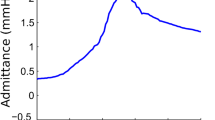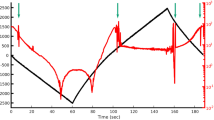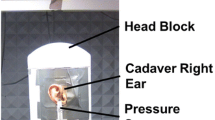Abstract
The purpose of the present work is to investigate the spatial vibration pattern of the gerbil tympanic membrane (TM) as a function of frequency. In vivo vibration measurements were done at several locations on the pars flaccida and pars tensa, and along the manubrium, on surgically exposed gerbil TMs with closed middle ear cavities. A laser Doppler vibrometer was used to measure motions in response to audio frequency sine sweeps in the ear canal. Data are presented for two different pars flaccida conditions: naturally flat and retracted into the middle ear cavity. Resonance of the flat pars flaccida causes a minimum and a shallow maximum in the displacement magnitude of the manubrium and pars tensa at low frequencies. Compared with a flat pars flaccida, a retracted pars flaccida has much lower displacement magnitudes at low frequencies and does not affect the responses of the other points. All manubrial and pars tensa points show a broad resonance in the range of 1.6 to 2 kHz. Above this resonance, the displacement magnitudes of manubrial points, including the umbo, roll off with substantial irregularities. The manubrial points show an increasing displacement magnitude from the lateral process toward the umbo. Above 5 kHz, phase differences between points along the manubrium start to become more evident, which may indicate flexing of the tip of the manubrium or a change in the vibration mode of the malleus. At low frequencies, points on the posterior side of the pars tensa tend to show larger displacements than those on the anterior side. The simple low-frequency vibration pattern of the pars tensa becomes more complex at higher frequencies, with the breakup occurring at between 1.8 and 2.8 kHz. These observations will be important for the development and validation of middle ear finite-element models for the gerbil.











Similar content being viewed by others
References
Alm P, Bloom G, Hellström S, Stenfors L, Widemar L (1983) Middle ear effusion caused by mechanical stimulation of the external auditory canal: an experimental study in the rat. Acta Oto-Laryngologica 96(1–2):91–98
Aziz PM, Sorensen HV, Van Der Spiegel J (2002) An overview of sigma-delta converters. Signal Processing Magazine, IEEE 13(1):61–84
Bigelow DC, Swanson PB, Saunders JC (1996) The effect of tympanic membrane perforation size on umbo velocity in the rat. Laryngoscope 106(1):71–76
Cheng JT, Aarnisalo AA, Harrington E, Hernandez-Montes MS, Furlong C, Merchant SN, Rosowski JJ (2010) Motion of the surface of the human tympanic membrane measured with stroboscopic holography. Hear Res 263(1–2):66–77
Cohen YE, Doan DE, Rubin DM, Saunders JC (1993) Middle-ear development. V: development of umbo sensitivity in the gerbil. Am J Otolaryngol 14(3):191–198
Decraemer WF, Khanna SM, Funnell WR (1989) Interferometric measurement of the amplitude and phase of tympanic membrane vibrations in cat. Hear Res 38(1–2):1–17
Decraemer WF, Khanna SM, Funnell WR (1991) Malleus vibration mode changes with frequency. Hear Res 54(2):305–318
Decraemer WF, Khanna SM, Funnell WRJ (1994a) A method for determining three-dimensional vibration in the ear. Hear Res 77(1–2):19–37
Decraemer WF, Khanna SM, Funnell WRJ (1994b) Bending of the manubrium in cat under normal sound stimulation. Proc Opt Imaging Tech Biomed 2329:74–84
Decraemer, W. F., Khanna, S. M., & Funnell, W. R. J. (1999). Vibrations at a fine grid of points on the cat tympanic membrane measured with a heterodyne interferometer. EOS/SPIE International Symposia on Industrial Lasers and Inspection, Conference on Biomedical Laser and Metrology and Applications.
Decraemer, W. F., de La Rochefoucauld, O., & Olson, E. S. (2011). Measurement of the three-dimensional vibration motion of the ossicular chain in the living gerbil. In C. A. Shera & E. S. Olson (Eds.), Proceedings of the 11th International Mechanics of Hearing Workshop 1403:528–533
Dirckx JJJ, Decraemer WF, von Unge M, Larsson C (1998) Volume displacement of the gerbil eardrum pars flaccida as a function of middle ear pressure. Hear Res 118(1–2):35–46
Dirckx JJJ, Decraemer WF (2001) Effect of middle ear components on eardrum quasi-static deformation. Hear Res 157(1–2):124–137
Doyle WJ, Alper CM, Seroky JT (1999) Trans-mucosal inert gas exchange constants for the monkey middle ear. Auris Nasus Larynx 26(1):5–12
Doyle WJ, Seroky JT, Alper CM (1995) Gas exchange across the middle ear mucosa in monkeys: estimation of exchange rate. Arch Otolaryngol Head Neck Surg 121(8):887–892
Ellaham, N. N., Akache, F., Funnell, W. R., & Daniel, S. J. (2007). Experimental study of the effects of drying on middle-ear vibrations in the gerbil. 30th Ann Conf Can Med Biol Eng Soc
Emgård P, Hellström S (1997) An animal model for external otitis. European Archives of Oto-rhino-laryngology 254(3):115–119
Eriksson P, Mattsson C, Hellstrom S (2003) First forty-eight hours of developing otitis media: an experimental study. Ann Otol Rhinol Laryngol 112(6):558–566
Flisberg K, Ingelstedt S, Örtegren U (1963) On middle ear pressure. Acta Oto-Laryngologica 56(S182):43–56
Fulghum RS, Marrow HG (1996) Experimental otitis media with Moraxella (Branhamella) catarrhalis. Ann Otol Rhinol Laryngol 105(3):234–241
Funnell WRJ (1983) On the undamped natural frequencies and mode shapes of a finite-element model of the cat eardrum. J Acoust Soc Am 73:1657–1661
Funnell WRJ, Khanna SM, Decraemer WF (1992) On the degree of rigidity of the manubrium in a finite-element model of the cat eardrum. J Acoust Soc Am 91(4):2082–2090
Funnell WRJ, Laszlo CA (1982) A critical review of experimental observations on ear-drum structure and function. ORL 44(4):181–205
Gea SLR, Decraemer WF, Funnell WRJ, Dirckx JJJ, Maier H (2009) Tympanic membrane boundary deformations derived from static displacements observed with computerized tomography in human and gerbil. J Assoc Res Otolaryngol 11(1):1–17
Hellström S, Goldie P, Salén B, Stenfors L-E (1985) Mechanisms in middle ear effusion production caused by irritation of the external auditory canal. Am J Otolaryngol 6(3):220–222
Hiraide F, Eriksson H (1978) The effects of the vacuum on vascular permeability of the middle ear. Acta Oto-Laryngologica 85(1–6):10–16
Hiraide F, Paparella MM (1972) Vascular changes in middle ear effusions. Archives of Otolaryngology—Head & Neck Surgery 96(1):45–51
Hutchings, M. (1987) The gerbil as an animal model of otitis media with effusion. J Physiol (London), 396:175
Ishihara M (1989) Experimental study of vibration analysis in middle ear models by holographic interferometry. Effects of the cross-sectioned area of aditus on the vibration of tympanic membrane. Nihon Jibiinkoka Gakkai Kaiho 92(5):726–735
Khanna SM, Tonndorf J (1972) Tympanic membrane vibrations in cats studied by time-averaged holography. J Acoust Soc Am 51:1904
Kohllöffel LUE (1984) Notes on the comparative mechanics of hearing. III. On Shrapnell’s membrane. Hear Res 13(1):83–88
Konrádsson KS, Ivarsson A, Bank G (1987) Computerized laser Doppler interferometric scanning of the vibrating tympanic membrane. Scand Audiol 16(3):159–166
de La Rochefoucauld O, Olson ES (2010) A sum of simple and complex motions on the eardrum and manubrium in gerbil. Hear Res 263(1–2):9–15
Larsson C, Dirckx JJJ, Bagger-Sjöbäck D, von Unge M (2005) Pars flaccida displacement pattern in otitis media with effusion in the gerbil. Otol Neurol 26(3):337
Lee C-Y, Rosowski JJ (2001) Effects of middle-ear static pressure on pars tensa and pars flaccida of gerbil ears. Hear Res 153(1–2):146–163
Maeta M (1991) Effects of the perforation of the tympanic membrane on its vibration—with special reference to an experimental study by holographic interferometry. Nihon Jibiinkoka Gakkai Kaiho 94(2):231–240
Nambiar S (2010) An experimental study of middle-ear vibrations in gerbils. Master of Engineering thesis. McGill University, Montréal, Canada
Okano K (1990) Influence of liquid volume in the middle ear on tympanic membrane vibration (experimental study by holographic interferometry). Nihon Jibiinkoka Gakkai Kaiho 93(11):1847–1855
Qin Z, Wood M, Rosowski JJ (2010) Measurement of conductive hearing loss in mice. Hear Res 263(1–2):93–103
Ravicz, M. E., & Rosowski, J. J. (1997) Sound-power collection by the auditory periphery of the Mongolian gerbil Meriones unguiculatus: III. Effect of variations in middle-ear volume. J Acoust Soc Am 10:2135
Ravicz ME, Rosowski JJ, Voigt HF (1992) Sound-power collection by the auditory periphery of the Mongolian gerbil Meriones unguiculatus. I: middle-ear input impedance. J Acoust Soc Am 92(1):157–177
Ravicz, M. E., Rosowski, J. J., & Voigt, H. F. (1996) Sound-power collection by the auditory periphery of the Mongolian gerbil Meriones unguiculatus. II. External-ear radiation impedance and power collection. J Acoust Soc Am 99:3044
Rosowski JJ, Cheng JT, Ravicz ME, Hulli N, Hernandez-Montes M, Harrington E, Furlong C (2009) Computer-assisted time-averaged holograms of the motion of the surface of the mammalian tympanic membrane with sound stimuli of 0.4–25 kHz. Hear Res 253(1–2):83–96
Rosowski JJ, Lee CY (2002) The effect of immobilizing the gerbil’s pars flaccida on the middle-ear’s response to static pressure. Hear Res 174(1–2):183–195
Rosowski JJ, Ravicz ME, Teoh SW, Flandermeyer D (1999) Measurements of middle-ear function in the Mongolian gerbil, a specialized mammalian ear. Audiol Neuro-otol 4(3–4):129–136
Rosowski JJ, Teoh SW, Flandermeyer DT (1997) The effect of the pars flaccida of the tympanic membrane on the ear’s sensitivity to sound. In: Lewis ER, Long GR, Lyon RF, Narins PM, Steele CR, Hect-Poiner E (eds) Diversity in auditory mechanics. World Scientific, New Jersey, pp 129–135
Sadé J, Ar A (1997) Middle ear and auditory tube: middle ear clearance, gas exchange, and pressure regulation. Otolaryng Head Neck 116(4):499–524
Stenfors L, Carlsöö B, Winblad B (1981) Structure and healing capacity of the rat tympanic membrane after eustachian tube occlusion. Acta Oto-Laryngologica 91(1–6):75–84
Suehiro M (1990) Effects of an increase or decrease in the middle ear pressure on tympanic membrane vibrations (experimental study by holographic interferometry). Nihon Jibiinkoka Gakkai Kaiho 93(3):398–406
Teoh SW, Flandermeyer DT, Rosowski JJ (1997) Effects of pars flaccida on sound conduction in ears of Mongolian gerbil: acoustic and anatomical measurements. Hear Res 106(1–2):39–65
Tonndorf J, Khanna SM (1972) Tympanic-membrane vibrations in human cadaver ears studied by time-averaged holography. J Acoust Soc Am 52:1221
Tos M, Poulsen G (1980) Attic retractions following secretory otitis. Acta Oto-Laryngologica 89(3–6):479–486
von Unge M, Decraemer W, Bagger-Sjöbäck D, Van den Berghe D (1997) Tympanic membrane changes in experimental purulent otitis media. Hear Res 106(1–2):123–136
von Unge M, Decraemer WF, Bagger-Sjöbäck D, Dirckx JJ (1993) Displacement of the gerbil tympanic membrane under static pressure variations measured with a real-time differential moiré interferometer. Hear Res 70(2):229–242
Voss SE, Rosowski JJ, Merchant SN, Peake WT (2000) Acoustic responses of the human middle ear. Hear Res 150(1–2):43–69
Wada H, Ando M, Takeuchi M, Sugawara H, Koike T, Kobayashi T, Hozawa K et al (2002) Vibration measurement of the tympanic membrane of guinea pig temporal bones using time-averaged speckle pattern interferometry. J Acoust Soc Am 111:2189
Zheng Y, Ohyama K, Hozawa K, Wada H, Takasaka T (1997) Effect of anesthetic agents and middle ear pressure application on distortion product otoacoustic emissions in the gerbil. Hear Res 112(1–2):167–174
Acknowledgments
The authors would like to thank Ms. Shruti Nambiar and Ms. Zinan He for their contributions to the development of the surgical and measurement techniques; Dr. Jim Gourdon for the advice on the anesthesia procedure; and Dr. Dan Citra for his help in dealing with the animals. This work was supported in part by the Canadian Institutes of Health Research, the Fonds de recherche en santé du Québec, the Natural Sciences and Engineering Research Council (Canada), the Montréal Children’s Hospital Research Institute, the McGill University Health Centre Research Institute and the Research Fund of Flanders (Belgium).
Author information
Authors and Affiliations
Corresponding author
Appendix
Appendix
An inset in Figure 8 shows the Nyquist plots for three anterior beads in the frequency range of 3,078 to 4,922 Hz, as an example of their use for verification of the phase response as mentioned in the “Measurement and analysis procedures” section. The unwrapped phases shown for these three beads follow what the Nyquist plots display regarding the phase evolution, which can be described in terms of “phasors,” that is, vectors drawn from the origin to points on the Nyquist plot. When for increasing frequency the phasor rotates clockwise, the phase angle decreases (becomes more negative), and vice versa. All three curves start in the same quadrant and end in that same quadrant, but the trajectories in between are quite different. At the beginning of the violet trajectory on the Nyquist plot, the phasor rotates clockwise through a small angle then counterclockwise, corresponding to a phase decrease up to about 3,300 Hz and then a phase increase up to about 3,650 Hz. After this frequency, it rotates clockwise, which corresponds to a decrease in phase up to a point where the phasor becomes extremely short and the trajectory becomes almost tangent to the real axis, at about 4,100 Hz. Approaching and passing this tangent zone, with the phasor still rotating clockwise and encircling the origin, causes a sharp drop in the phase plot, after which the phasor becomes longer and continues to rotate clockwise, corresponding to a smooth phase drop. (When the phasor becomes very short, a very small difference in the real or imaginary parts due to noise or frequency resolution can change whether it encircles the origin or not, which in turn causes a difference of 360 ° in the phase.) The phasors for the blue and gray trajectories start rotating clockwise and both of them make circles, but the gray trajectory encircles the origin while the blue trajectory does not. This corresponds to a continuous drop of the gray phase plot, but an increase at about 4 kHz in the blue phase plot.
Rights and permissions
About this article
Cite this article
Maftoon, N., Funnell, W.R.J., Daniel, S.J. et al. Experimental Study of Vibrations of Gerbil Tympanic Membrane with Closed Middle Ear Cavity. JARO 14, 467–481 (2013). https://doi.org/10.1007/s10162-013-0389-9
Received:
Accepted:
Published:
Issue Date:
DOI: https://doi.org/10.1007/s10162-013-0389-9




